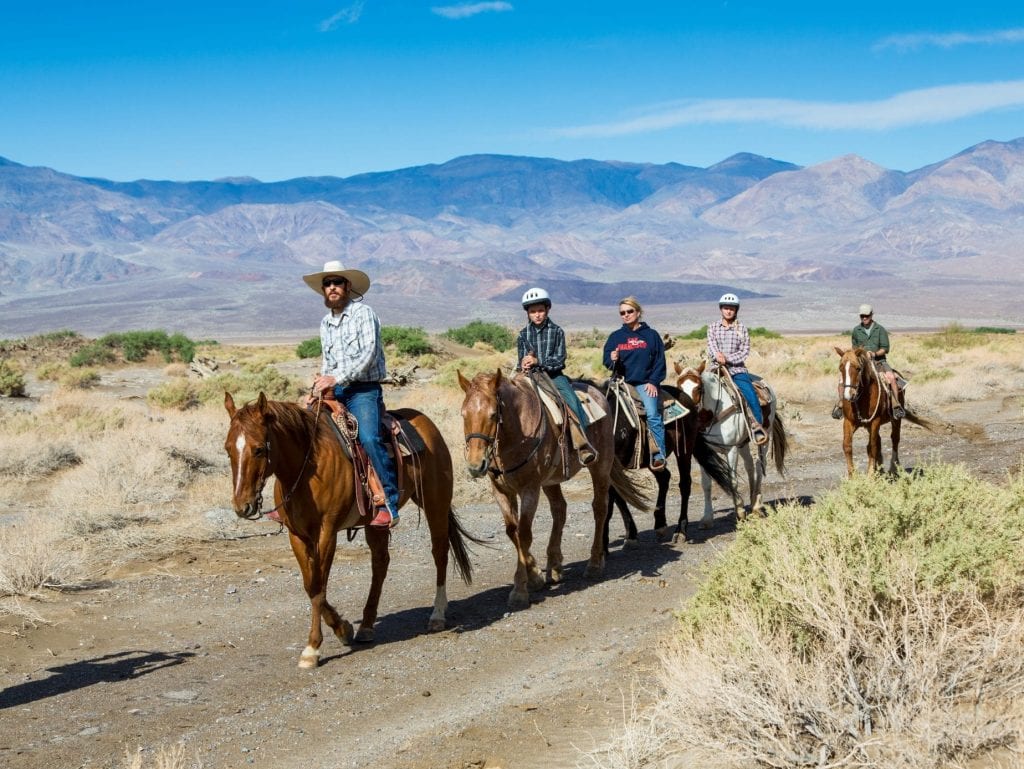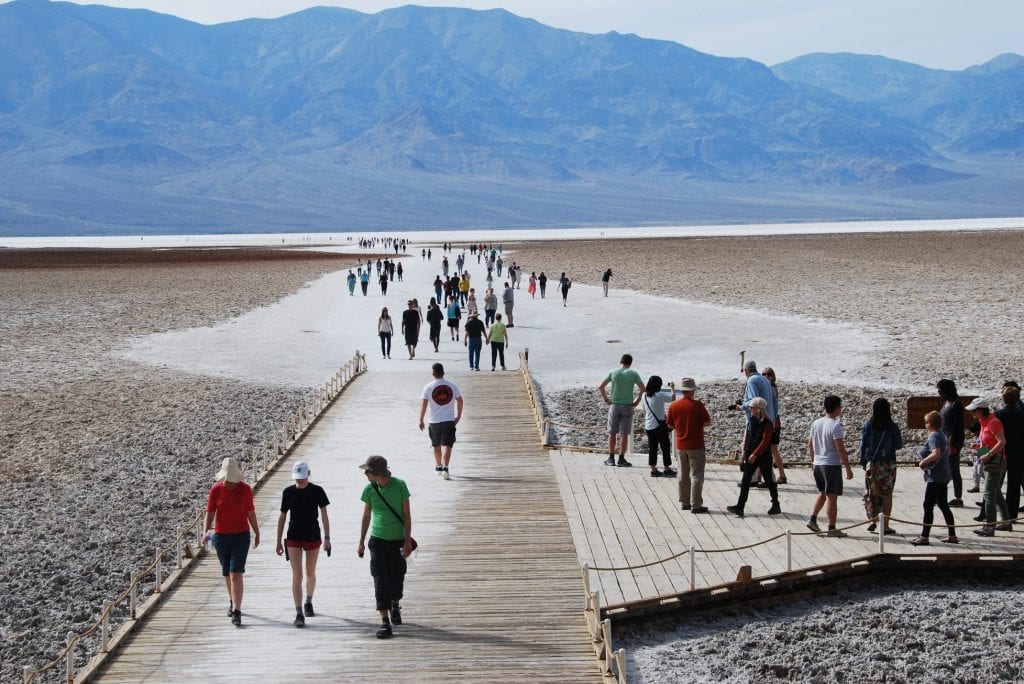“I’m allowed to eat the dirt?” my son asks, an incredulous look on his face. I nod and explain that the white ground we’re standing on is not dirt but, rather, salt, and the friendly park ranger said a wee taste was fine. With that, my son pops a pinch in his mouth and the rest of us follow suit. The family consensus? That is some salty salt.
Such is the wonder (and the fun) to be found on a getaway in Death Valley National Park. Because despite its morbid name and well-deserved reputation as a land of extremes – the lowest point in the country (282 feet below sea level at salty Badwater Basin), the driest place in North America (the average annual rainfall is less than two inches) and the hottest place on Earth (the world’s highest air temperature, 134 degrees Fahrenheit, was recorded here) – Death Valley has all the ingredients for a lively family vacation.
To ensure quality family time, pay attention to three things: the best time to visit (November through April, when valley temperatures are more moderate), how long to visit (at least two nights but, really, make it three) and where to stay (central to sights you most want to see).
Driving In
Depending on your departure point, Death Valley National Park is about 275 miles from L.A. Inside the park, Highway 190 becomes a twisty ribbon of road. Take a break at Father Crowley Vista Point, where you can stretch your legs and, if lucky, watch fighter jets on training exercises streak through Rainbow Canyon below you.
Once you’re on the valley floor, the vastness of this 3.4-million-acre national park, the largest outside of Alaska, sinks in. If it’s time for ice cream amidst all the grandeur, stop at Stovepipe Wells Village, where the valley’s first hotel was opened in 1926. Just beyond the village are the Mesquite Flat Sand Dunes, a definite must-do now or later in the trip.
Staying Central
Although Stovepipe Wells has a hotel, restaurant and campground, for my money the Oasis at Death Valley is a better home base. Formerly known as Furnace Creek Resort, the Oasis is located close to the park’s most impressive sights and offers restaurants, a campground, well-stocked general store, golf course, horse stables and two accommodations options.
For a spoil-your-family-silly stay, choose the luxurious Inn at Death Valley. Originally opened in 1927, this California Mission-style retreat offers elegant rooms and brand-new casitas, broad terraces shaded with palm trees, a fancy restaurant and bar and a to-die for spring-fed swimming pool complete with deck-side stone fireplaces, cabanas and spa.
The second Oasis property, the Ranch at Death Valley, is a more family- and budget-friendly option. There’s room for kids to run here, with expansive lawns, a playground, sports courts and a large, spring-fed swimming pool that, according to the 7-year-old girl I met in the shallow end, is “like, really, the very best thing about here.”
Getting Oriented
To ensure your children get excited about more than the pool, involve them in pretrip planning. Search the web together for interesting things to do and see. Print photos of places that interest the kids most and have them paste the photos into a scrapbook. Once in Death Valley, young children will get a kick out of seeing the real sights depicted in their scrapbooks, while school-age children can write their impressions beside their photos.
The park’s Junior Ranger program is another great way to engage children. Stop by the national park’s visitor center and pick up a booklet with fun activities to complete to earn a free Death Valley junior ranger badge. At the end of our family visit, my sons presented their completed booklets to a ranger who carefully reviewed their work and then called over his fellow rangers to applaud as he presented my sons with their badges.
In addition to enthusiastic rangers, the Furnace Creek Visitor Center is chock-full of helpful resources. Be sure to watch the center’s 20-minute film and wander through interactive displays that explain the park’s geology, climate, wildlife and history, including stories about the Timbisha Shoshone people who’ve lived here for thousands of years (and who – it must be noted – sell delicious frybread tacos and shaved ice at their village center adjacent to the Oasis).
Exploring Badwater Road
A classic Death Valley day begins with a drive south along Badwater Road toward the lowest point in North America at Badwater Basin (pictured above left and opposite page, right). On the way, stop at the Devil’s Golf Course to marvel at spiky salt spires that are the residue of a lake that evaporated more than 2,000 years ago. At Badwater Basin, snap the obligatory photo of the kids standing beside the “282 feet below sea level” sign, then walk out on the shimmering salt flats. When you turn to walk back, look high up on the mountainside for a white sign indicating sea level. “That is sooooo cool,” my sons said.
Returning north, detour along the dipping, curving nine-mile Artist’s Drive. Here, during one of Death Valley’s most explosive volcanic periods, magma-heated water met lava, ash and lake sediments and colored the rocks a riotous mix of sea green, lavender blue, pink, purple, red and yellow. Pull off at the Artist’s Palette parking lot to have a closer look and ponder this piece of “Star Wars” trivia: It was here in 1976 that director George Lucas filmed the Jawas carrying R2-D2 in the deserts of Tatooine.
In fact, several “Star Wars” scenes have been filmed in the park, including at the next recommended stop, Golden Canyon. Grab your water bottles and hike a mile through narrow passageways and colorful hills to the Red Cathedral spur. From here you can turn back to the parking lot or continue another half-mile to the impressive natural amphitheater. Or, if the family is ready for an exceptional hike, continue southeast for 3.3 miles on a loop trail that climbs through golden-colored badlands and descends to Gower Gulch. Finish your outing at Zabriskie Point, where the late-day sun super-soaks the surrounding golden badlands.
Taking It All In
After this fairly structured day, take a more relaxed approach to the rest of the park. You might bundle together a walk through the polished-marble gorge in Mosaic Canyon with a stop at Mesquite Flats Sand Dunes. On our visit to the dunes, we followed the advice of park rangers and, rather than heading for the 100-foot high dunes, we veered right to see footprint-free sand decorated with the wiggly tracks of sidewinder snakes and tiny paw prints of kangaroo rats.
To see the hands-down best view in the park, drive east to Dante’s View. Here, a short trail leads to a vantage point with sweeping vistas of the entire valley, the mountain ranges that surround it and the valley floor some 5,000 feet below.
Another remarkable spectacle awaits when you venture out after dark. Death Valley’s night skies are some of the darkest in the country, which means that on a good night, you can see the Milky Way and its billions of stars with the naked eye. Consider joining a ranger-led night-sky program or, if you’re in the park when the Las Vegas Astronomical Society sets up its telescopes (next scheduled visit is Nov. 2 and 3), enjoy a tour of the night sky with these amateur astronomers.
Or perhaps the best way for your children to experience the darkest sky they’ve ever been under, in the most remote desert they’ve ever visited, in one of the most exceptional places on Earth, is to pile into your vehicle, drive to a dark spot in the park and simply look up.
Getaway Details
Entrance fees: For a vehicle and occupants: $30. Or, if you have a fourth-grade student in your household, it’s free! Just print an “Every Kid in a Park” pass from everykidinapark.gov and enjoy free entrance to Death Valley National Park and hundreds of other federal sites.
Bring: Refillable water bottles, a variety of snacks, wide-brimmed hats and warm jackets for nighttime adventuring
Stay: Oasis at Death Valley, oasisatdeathvalley.com
Learn more: Death Valley National Park, nps.gov/deva




























